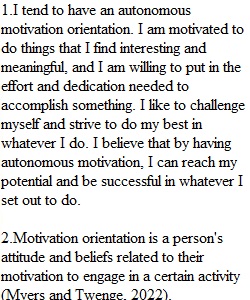


Q PSY 355 Module One Milestone Template Complete this template by replacing the bracketed text with the relevant information. Part One In 3 to 5 sentences for each rubric criterion, apply the conceptual foundations of motivation orientation to your lived experience by responding to the following: 1. Describe which motivation orientation, autonomous or controlled, is most relevant to you and why. [Insert text] 2. Describe how motivation orientation influences level of engagement. [Insert text] 3. Describe an authentic example of how conformity has been both detrimental and essential to your well-being. [Insert text] 4. Describe the strengths and limitations of an autonomously motivated mindset as it applies to emotional intelligence. [Insert text] Part Two Next, in 3 to 5 sentences for each criterion, describe the practical applications of motivation orientation within the leadership context by responding to the following: 1. Describe the types of values that you believe would help to promote an autonomously motivated mindset in those you serve. [Insert text] 2. Describe how you could support others in their own motivation. [Insert text] 3. Describe an example of how your understanding of motivation orientation can help you engage in more compassionate, empathetic leadership. [Insert text]
View Related Questions